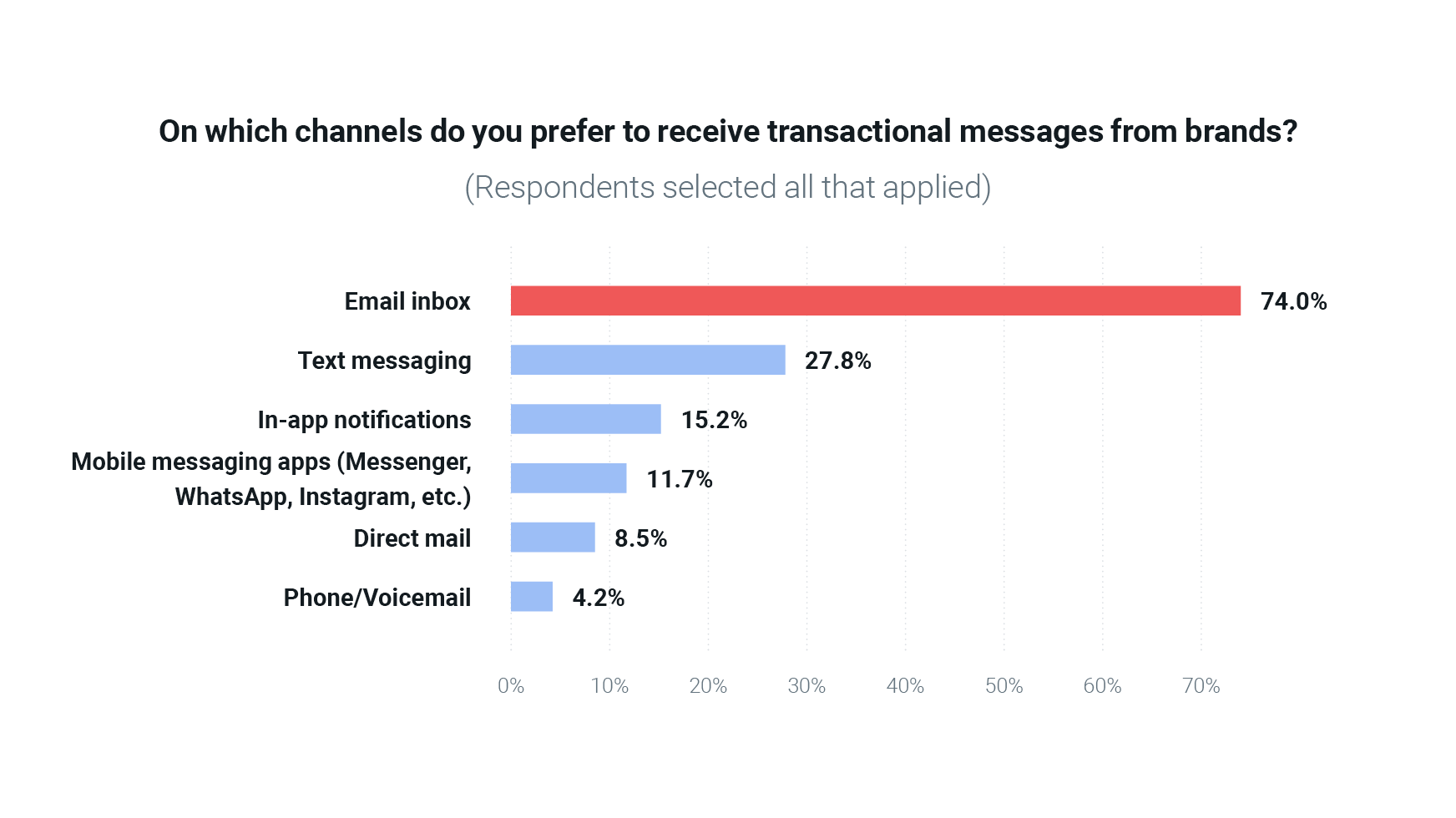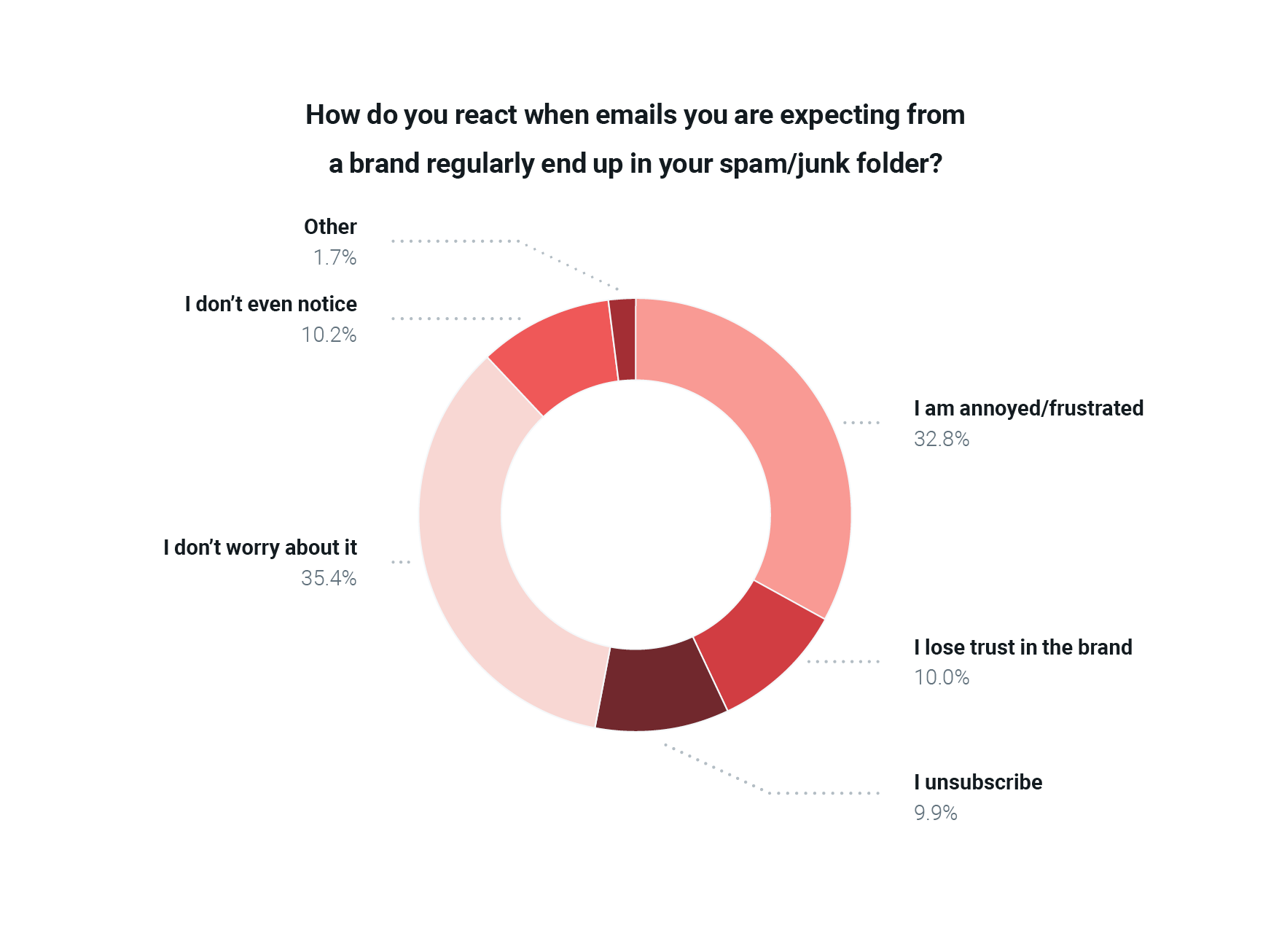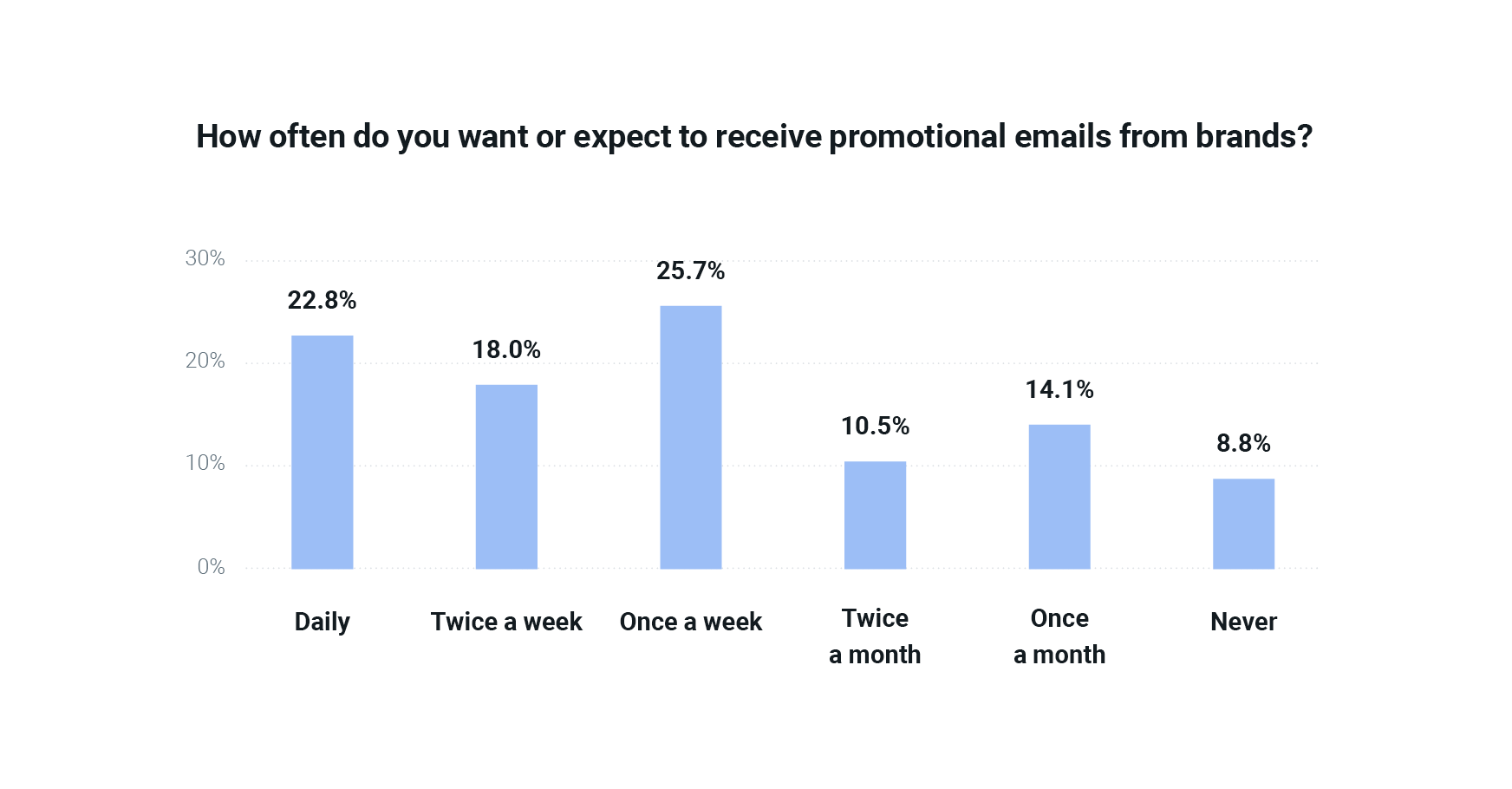Deliverability
Email deliverability and the customer experience: What are the connections?
Your customers rely on their inboxes to stay informed. You rely on the email channel to deliver important messages that drive website traffic and repeat business. What happens to the customer experience when inbox placement becomes an issue? Get insights from our global consumer survey.
PUBLISHED ON
Whether it’s business or personal, relationships are built on trust. Good communication fosters that trust. For strong communication between your company and your customers, nothing does the job quite like email, especially for B2C. But what happens if the email channel lets you or your customers down?
Consumers are accustomed to getting emails from brands and many of them prefer the channel. Our Email and the customer experience report found around 75% of respondents would choose email for receiving both promotional and transactional messages. When you struggle with inbox placement and emails land in spam, it disrupts the customer experience, which damages your reputation.
Thankfully, a solid email deliverability strategy helps keep your business running smoothly, delivering the ideal customer experience.
Consumers in a world without email
Imagine the email inbox doesn’t exist. Ray Tomlinson never invented email and brand communications remain stuck in the ‘70s vortex of color-saturated print ads and competitive commercial spots (Shudder.)
Thankfully, that’s not the case. Today, we have infinite channels and opportunities to transmit messages, and it can be easy to take email’s role in the customer experience for granted. Email has been around for decades. It’s reliable, effective, and delivers an impressive return on investment (ROI). For your customers, email is also extremely convenient. It’s so good at what it does we barely even notice it’s happening. That is – until something goes wrong.
Email communications are sort of like the offensive line in American football. You don’t really think much about them until someone misses a block and the quarterback gets sacked.
Put yourself in the shoes of a customer or application user for a minute. How would you feel if you requested a password reset and it didn’t show up in your inbox?
How would you react if there was an amazing deal from your favorite retail brand, but you missed it? The email campaign landed in spam and now that special promotion is over.
Here’s the thing... Customers expect your emails to be reliable, relevant, and timely. In many cases, they are actively anticipating what you’re sending. So, when a message fails to show up, or consumers are forced to search for it in their spam folder, that’s not just a bad customer experience, it’s a missed opportunity.
Let’s look at two foundational ways email supports the customer experience and why deliverability is so important. We’ll also offer some advice on making sure these emails have a better chance of reaching your customers’ inboxes.
Transactional email experiences
Transactional emails are the unsung heroes of the customer experience. Many consumers are also becoming more familiar with SMS for transactional messages. 27.8% of survey respondents chose text messaging as a preferred option. That’s good enough for second place, but an impressive 74% of consumers said they prefer email for transactional messages.

Unlike a promotional email campaign that’s sent to a large list of customers and subscribers, automated transactional emails are triggered by and meant for one person, and they often contain important personal information.
It could be the receipt for an online order, a subscription renewal, or a shipping update. It could also be an urgent security notification, a password reset, or an email confirming their dinner reservation. Whatever the case, transactional messages should arrive in the inbox almost immediately.
If they don’t, your customers will wonder what’s going on. They’re going to get frustrated. Then they might look for the message in their junk mail. 71% of consumers said they would check spam for a missing transactional email. Another 16% would do so only if the email was important.

The fact that so many people are willing to sift through spam to find a missing transactional email certainly says something. It means these messages matter to customers. It does not mean there’s no reason to worry about transactional email deliverability.
What people say they do can be quite different from how they behave in real life. Instead of checking spam, they might complain or call customer service about a missing transactional email. Even if they do find that missing email in spam, it’s likely they’ll have a negative reaction.
Close to one-third of consumers in our survey (32.8%) say they’d be annoyed or frustrated if your brand’s emails regularly end up in spam. Another 10% say they’d lose trust in your brand, and almost as many say they’d unsubscribe from your emails.

While this survey result isn’t specific to transactional emails, it’s safe to assume your customers’ reactions would be even more negative if it were. That’s because transactional messages are crucial to the customer experience.
Transactional email deliverability advice
Mailbox providers understand that transactional emails are important to the recipients who use their services. They don’t want to upset their users by filtering those messages into spam. To make message intention clearer to mailbox providers, there are some things senders can do to identify when email traffic is transactional and not marketing related.
Many senders choose to separate transactional emails and promotional emails on different subdomains or sending IPs. For example, your newsletters and promotions would come from marketing.domain.com and transactions would get sent from orders.domain.com.
Mailgun’s State of email deliverability 2025 found more than half of high-volume bulk email senders separate transactional and promotional email traffic. This practice is all about managing IP and domain reputation.
Promotional emails don’t get as high a level of engagement as transactional messages, which means email promotions are more likely to land in spam. Consumers are also more likely to make spam complaints about promotions. What you want to avoid is customers or providers confusing these two types of emails. Otherwise, transactional emails could suffer the same fate as unwanted promotions.
Trying to sneak too much promotional messaging into your transactional emails could also cause deliverability problems. If your transactional messages start to seem too “selly,” recipients may view it as spam and report it.
Promotional email experiences
Promotions are part of a good customer experience. Consumers in our survey also favored the email channel for this type of customer communication. More than 75% of the 2,000+ people we questioned chose their email inbox as a place they’d like to receive promotional messages.

While promotions delivered via text messaging or mobile messaging are less common, people are starting to see value in these channels. Nearly 1 out of 5 consumers currently prefer promotional SMS campaigns (text messaging) and more than 12% want marketing messages sent to mobile apps like Messenger, WhatsApp, or Instagram.
Transactional messages are a consumer expectation. They may not add perceived value because transactional email delivery is table stakes. One thing that makes promotional emails different is that consumers must opt in to receive them. In other words, people usually want them. It’s often the purpose of subscribing in the first place.
When asked to choose the primary reason they sign up to receive emails from brands, the top option was connected to regularly receiving special offers (32.7%). That’s followed by consumers who subscribe to get a one-time discount (23%).

The challenge for email marketers is building a program that delivers promotional messages that are personal and relevant to different customers. Consumers have a wide range of opinions on what the ideal experience looks like to them.
For example, when we asked participants how often they want to receive promotional emails from brands, results were well-distributed across all options. While 25.7% of consumers expect to receive promotional emails weekly, 22.8% expect these emails daily. Another 8.8% never want email promotions. So, how do you respect the wishes of everyone on your list?

An email preference center is one solution. It lets consumers tell you how often they want to hear from you, but that means they must visit the preference center and make choices.
Senders can also monitor email metrics to strategically segment their list based on engagement. People who open and click more often may get a promotional email every week, while less engaged subscribers hear from your brand once a month.
Our survey found these are the top three reasons why consumers decide to unsubscribe:
Too many emails from the brand (19.8%)
No longer interested in the offerings (17.9%)
Email content is irrelevant to me (17.3%)
In all three of these situations, list segmentation helps you deliver an email experience your customers prefer.
Segmentation makes your email strategy more targeted towards individual recipients, which supports a good customer experience. It means your promotions are more likely to stay interesting and relevant while you avoid overwhelming people with messages they don’t care about.
Promotional email deliverability advice
Two of the most impactful things you can focus on to support good inbox placement for email promotions are your list building practices and good email list hygiene.
This should go without saying, but you should never purchase lists of contacts or scrape the web to find email addresses you can add to your list. These shady tactics might seem like easy ways to grow a list and reach new people, but it is also good way to get sent to spam. That’s because spamming is exactly what you’re doing if these contacts haven’t opted in.
A more effective approach to list building involves using a double opt-in, which asks new contacts to confirm their decision to subscribe before they’re officially added. This method ensures new contacts are likely to engage, and it also helps you adhere to consumer privacy laws like GDPR.
When we asked consumers how they react to getting an unsolicited email from brands, 40.8% said they’d delete the spam email while 23.1% would ignore it. While this doesn’t sound like it could hurt deliverability, it will. If lots of contacts ignore or delete your promotional emails, it’s a strong signal to mailbox providers that you’re not wanted in the inbox. So, off to the junk folder you go.

An even bigger deliverability concern involves nearly 20% of consumers who’d mark an unsolicited email as spam. While it’s a less common behavior than the other options in the top three, making a spam complaint will have a direct impact on deliverability.
Gmail and Yahoo announced new guidelines for bulk senders, which will be enforced in 2024. They include a very specific threshold for spam complaints. If you regularly exceed a complaint rate of 0.1% (1 for every 1,000 messages delivered), or hit spikes above 0.3%, you’re going to have inbox placement issues with Gmail and Yahoo.
To learn more about the updated sender requirements, check out this Sinch Mailgun webinar with representatives from both Gmail and Yahoo. Get your questions answered.
Use a double opt-in to be sure you only add engaged contacts to your list. Make it easy to unsubscribe so that uninterested contacts won’t mark emails as spam instead.
Inbox placement = customer satisfaction
We also conducted a global survey of senders for another report, The state of email deliverability 2025. We asked senders who prioritize inbox placement to select what they consider to be the biggest benefits of good email deliverability.
Improving the customer experience is a growing desire among senders. In Sinch Mailgun’s recent State of email deliverability report, 45% of senders chose customer experience factors as the biggest benefits of prioritizing email deliverability. CX benefits like reliable communication and customer satisfaction even beat out reaching leads and increasing revenue.
What do you believe is the biggest benefit with prioritizing email deliverability and inbox placement?
The reason is simple: Email is an indispensable part of the customer experience because it is foundational to customer communications. Failure to reach the inbox can lead to frustration, disappointment, and a loss of trust.
If you’re serious about improving inbox placement, check out Mailgun Optimize. It’s a complete email deliverability suite with solutions that give you visibility into what’s happening along with tools to make improvements. You can use Mailgun Optimize with any email service provider (ESP).
How to deliver what consumers want
Email and the customer experience 2024
The inbox is a cornerstone of customer communications, but it’s not easy to get people to open and click your emails. Find out what consumers have to say about how they prefer to hear from brands. Discover the results of a global survey and give them what they want. Download your copy now. No form filling required.





